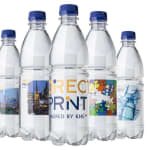 Maximum product protection with the minimum input of materials, decorative design to stimulate purchase, and resource efficiency in production, storage and transport - the requirements are very diverse. K 2016 will present innovations in design, production and applications for a huge variety of packaging materials and production methods. This article examines the trends in packaging and takes a brief look ahead to the highlights of actual exhibits at the fair.
Maximum product protection with the minimum input of materials, decorative design to stimulate purchase, and resource efficiency in production, storage and transport - the requirements are very diverse. K 2016 will present innovations in design, production and applications for a huge variety of packaging materials and production methods. This article examines the trends in packaging and takes a brief look ahead to the highlights of actual exhibits at the fair."The packaging of tomorrow is smart and geared to specific target groups and convenience." That is what was written five years ago in the packaging sector report of IG Metall and IG Bergbau, Chemie, Energie (trade unions for the metalworking, mining, chemical and energy industries). And nothing of this will change in the coming years either. For in its most recent report "The Future of Global Packaging to 2020", Smithers Pira in Leatherhead, UK, has again identified re-closable convenience packages, extended shelf life, easy-open packages and on-the-go packages as the outstanding trend themes of a sector that continues to show overall growth. The world market will grow, Smithers Pira claims, by 3.5% from USD 839 billion in 2015 to USD 998 billion in 2020. This momentum in the packaging market is being driven principally by Asia but also by Western and Eastern Europe, with growth being stimulated among other things by advancing urbanisation and the subject of sustainability.
Packages are required in almost all sectors. While usually protecting the product and facilitating storage and transport, they can also help to differentiate products at the point of sale and thus constitute a selling point. In the past, packaging solutions have been consistently brought into line with market requirements and customer needs. Examples of this are distinctive crystal-clear bottles for household, and body and hair care products, sparkling high-quality plastic flacons for perfumes, special deep-drawn trays for electronics articles providing protection from electrostatic discharge and designed for product insertion by robot, and foldable transport boxes and stretch films for securing loads in trucks, to name but a few.
The food industry enjoys high attention and market importance within the packaging sector. In Europe countries alone, some 60% of foods still spoil, and this figure could be reduced significantly with appropriate packaging. What is more, according to a publication by packaging market researchers Gesellschaft für Verpackungsmarktforschung (GVM), product protection is always also climate protection, which in a turn is a subject of social relevance. The carbon footprint for the production of a new food to replace one lost due to inadequate product protection is usually much larger than that for the production of a suitable package that prevents spoilage.
The packaging sector continues to boom - and with it the requirements it has to meet, its possibilities and the innovative solutions. Its sheer diversity cannot be covered exhaustively in a single article, so only a selection of topics and examples have been picked out in the following without any claim to being comprehensive.




